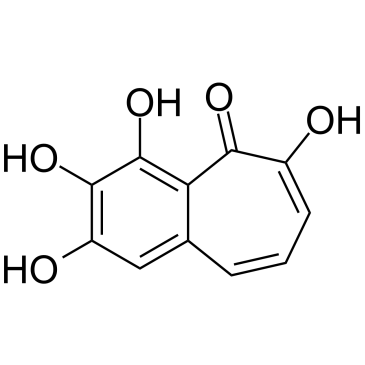569-77-7
| Name | purpurogallin |
|---|---|
| Synonyms |
2,3,4,6-Tetrahydroxy-benzocyclohepten-5-on
Purpurogalline 2,3,4,6-Tetrahydroxybenzocyclohepten-5-one 2,3,4,6-tetrahydroxy-5H-benzo[7]annulen-5-one 2,3,4,6-tetrahydroxy-5H-benzocyclohepten-5-one 2,3,4,5-tetrahydroxybenzo[7]annulen-6-one EINECS 209-324-9 MFCD00004145 |
| Description | Purpurogallin is a naturally phenol extracted from the plants of Quercus spp, has potent xanthine oxidase (XO) inhibitory activity with an IC50 of 0.2 µM. Purpurogallin has antioxidant and anti-inflammatory effects[1][2][3]. |
|---|---|
| Related Catalog | |
| Target |
IC50: 0.2 µM (xanthine oxidase)[3] |
| In Vitro | Purpurogallin (50 or 100 µM; 7 or 25 hours; BV2 murine microglial cells) treatment attenuates the production of pro-inflammatory cytokines, including interleukin-1β (IL-1β) and tumor necrosis factor-α (TNF-α) by suppressing their mRNA and protein expression in LPS-stimulated BV2 microglial cells[1]. Purpurogallin (100 µM; 75-120 minutes; BV2 murine microglial cells) exhibits anti-inflammatory properties by suppressing the phosphatidylinositol 3-kinase/Akt and mitogen-activated protein kinase signaling pathways in LPS-stimulated BV2 microglial cells[1]. RT-PCR[1] Cell Line: BV2 murine microglial cells Concentration: 50 or 100 µM Incubation Time: 7 or 25 hours Result: Attenuated the production of pro-inflammatory cytokines, including interleukin-1β (IL-1β) and tumor necrosis factor-α (TNF-α) by suppressing their mRNA and protein expression. Western Blot Analysis[1] Cell Line: BV2 murine microglial cells Concentration: 100 µM Incubation Time: 75 minutes, 90 minutes, 120 minutes Result: Suppressed the phosphatidylinositol 3-kinase/Akt and mitogen-activated protein kinase signaling pathways. |
| In Vivo | Purpurogallin (100-400 μg/kg; intraperitoneal injection; for 48 or 72 hours; male Sprague-Dawley rats) exerts its neuroinflammation effect through the dual effect of inhibiting IL-6 and TNF-α mRNA expression and reducing HMGB1 protein and mRNA expression[2]. Animal Model: Fifty-four male Sprague-Dawley rats (250-350 g) with subarachnoid hemorrhage (SAH)[2] Dosage: 100 μg/kg, 200 μg/kg, 400 μg/kg Administration: Intraperitoneal injection; for 48 or 72 hours Result: Dose-dependently reduced HMGB1 protein expression. High dose reduced TNF-α and HMGB1 mRNA levels. |
| References |
| Density | 1.74g/cm3 |
|---|---|
| Boiling Point | 357.9ºC at 760mmHg |
| Melting Point | 275ºC (dec.)(lit.) |
| Molecular Formula | C11H8O5 |
| Molecular Weight | 220.17800 |
| Flash Point | 184.5ºC |
| Exact Mass | 220.03700 |
| PSA | 97.99000 |
| LogP | 1.02240 |
| Index of Refraction | 1.79 |
| HS Code | 2914400090 |
|---|---|
| Summary | 2914400090 other ketone-alcohols and ketone-aldehydes。Supervision conditions:None。VAT:17.0%。Tax rebate rate:9.0%。MFN tariff:5.5%。General tariff:30.0% |
